How To Use Albuterol Without A Nebulizer
My wife and I recycle almost everything: cans, drinking glass, aluminum, plastic, and paper/cardboard. We have a huge compost pile for leaves, lawn trimmings, twigs, and pine needles. Of form it is highly-enriched when nosotros clean the craven coop.
We are on well water and fortunately, our deep well produces an adequate amount of common cold, fresh, and untreated water. My simply guilt is that I love ice-cold bottled water in those plastic bottles. I find them perfect to partially freeze and find them convenient when traveling. Since my bout with kidney stones, I am forced to drink a gallon or so of h2o per mean solar day. Working outside, I find it easier to grab a few cold bottles from the fridge and bring them with me to the garden. I can't drink out of the hose, since this is untreated, irrigation h2o.
We don't throw abroad the plastic water bottles. I envision a time when I volition refill them from our well water (assuming they are non dirty), and simply use them over and over. At this time, most of these bottles only get in the plastic recycling bins.
We had a crew of tree-trimmers at our domicile recently, removing the mistletoe that was slowly killing the oaks, and a few precarious, oak branches that, if they snap, would surely kill me. These guys use recycled gallon milk bottles for their water, which became warm to hot from sitting outside all day. Unless I was dying of thirst, my option would not be to drink warm water. As a kid in Pennsylvania, we would walk miles to a spring that was bubbling out of the ground. This water was soooooo cold that your hands would freeze when you cup them together to potable your make full. If I had a cold leap on my properly, I would never move.
I have a lot of asthmatic patients — mostly children. In order for kids to use a hand-held MDI (multi-dose inhaler) for albuterol or inhaled corticosteroids, they must have a spacer — a sleeping accommodation-like device where the medicine is sprays, and the child tin easily inhale it without having the coordination to time their inhalations with the spray.
Well-nigh insurance companies volition pay for asthma medications, but a surprising number of them will not pay for a medical spacer. These tin can cost $30 or more, depending on the type. Someone without health insurance (many), or those with really crappy insurance (most of us), may not take the extra income to purchase the least-expensive spacer. What happens is that they try administering the medication without information technology. Inhaled asthma medications are not constructive if they don't brand it to your lungs. When I ask parents to demonstrate how their children are using the inhaler, I finally understand why they are non improving. The kids are just getting the medicine in their mouths, not their lungs.
I have a cleverly-subconscious hoard of pharmaceutical company supplied spacers that I requite out for costless for families who do not have the resources to purchase them. In the bound, when allergies are the highest, my supply runs out quickly. Either that, or my married woman who uses my office on my day off, has found my stash.
Years ago, I would cover the individual practise of an elderly physician so that they could go a fiddling holiday. They were nearly 90 years old and still practicing. They would have their asthma patients salve the empty toilet paper tubes to use every bit an inhaler. They would work for a fourth dimension, merely since they were made of newspaper, they would bend, wear out, or exist discarded if seen lying around. This gave me an idea.
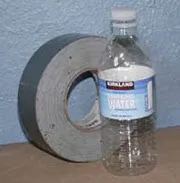 Every year or so, our state medical briefing holds a contest called "Two Minutes; Two Slides, Two Questions" where the participants are limited to a two-minute lecture, using simply two PowerPoint slides, and answer merely two questions at the cease. I have won for about three years in a row. I would like to share i of my entries with you: The H2o Canteen Spacer.
Every year or so, our state medical briefing holds a contest called "Two Minutes; Two Slides, Two Questions" where the participants are limited to a two-minute lecture, using simply two PowerPoint slides, and answer merely two questions at the cease. I have won for about three years in a row. I would like to share i of my entries with you: The H2o Canteen Spacer.
Supplies Needed:
- Discarded, but clean, small plastic water bottle
- Roll of duct record
- Sharp knife
Steps:
1. Carefully cut the bottom off of the h2o bottle, as well as part of the mouth piece.
2. Using strips of duct tape, encompass the sharp edges where you have cut
3. Take more duct record and create a smaller opening at the mouth end — an opening or even a slit that will temporarily and snugly fit the inhaler. If you have an one-time nebulizer mask, y'all can adhere this with duct tape instead.
4. Hold the bottom end around the mouth (or over the oral fissure and nose); spray the proper dose of the asthma medication, and just inhale. The bottle may fifty-fifty collapse a bit confirming a proper inhalation.
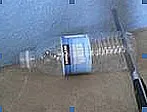

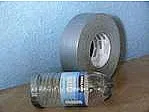
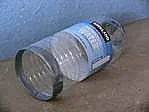
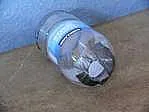
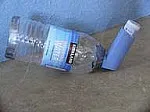
For this entry, I won a $50 souvenir document at a book store, and upset another clinician who challenged my personal ecology for using plastic water bottles in the kickoff-place. Their entry lost; they were just a sore loser.
Photos: Rod Moser
-

Heart Health
Menopause and Heart Wellness
May 30, 2022
Lower estrogen levels and your personal health history pair up to present special challenges to your heart health at midlife. Hither'southward how menopause affects ...
-

Substance Abuse
How I Realized I Had a Problem
May 27, 2022
I always knew there was a problem, I just thought, it was everyone else – but not me. If I had a problem, it was with your trouble ....
How To Use Albuterol Without A Nebulizer,
Source: https://blogs.webmd.com/from-our-archives/20110706/homemade-asthma-nebulizer-a-new-use-for-recycled-water-bottles
Posted by: hawkinsthithers.blogspot.com


0 Response to "How To Use Albuterol Without A Nebulizer"
Post a Comment